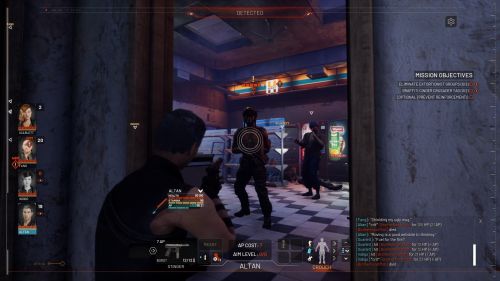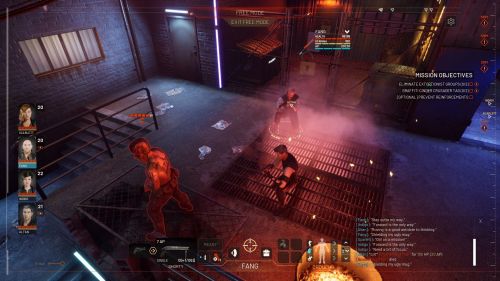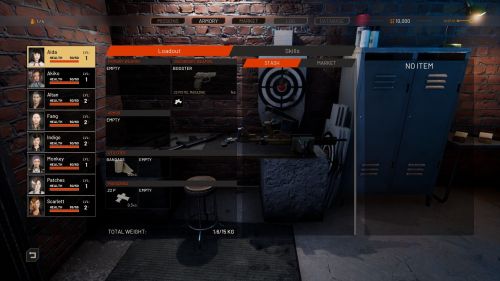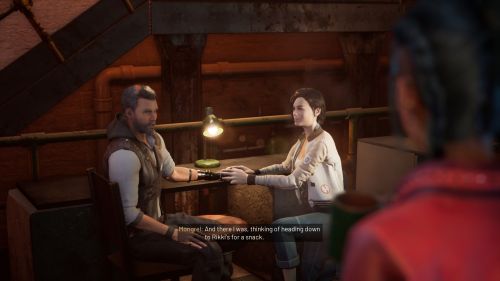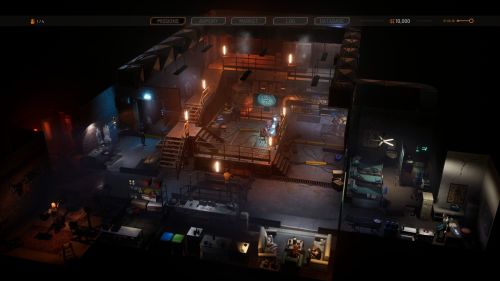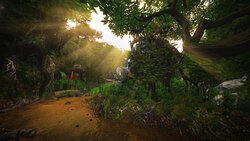RPG Codex Interview: Sérgio Gil on Project Haven
RPG Codex Interview: Sérgio Gil on Project Haven
Codex Interview - posted by Infinitron on Sat 15 July 2023, 18:09:56
Tags: Code Three Fifty One; Project Haven[Interview by udm]
Hey re.var, thanks for agreeing to do this interview. I think it's safe to say that Project Haven is one of the most anticipated games of this year (if it doesn't get pushed back again) for many Codexers. First of all, can you give us an introduction to Code Three Fifty One, as well as what got you guys into game development?
Hey! Thanks for having me. Truly appreciate the interest in Project Haven! We've always been avid gamers since childhood back in the early 90's, and like many always wanted to make our own games. I've personally started my professional game dev career in 2000 and have been making games since. Joana has a master's in Psychology and a PhD in Computer Science and Artificial Intelligence, she always loved games, particularly games with a good story. Back in 2015 we started creating a game together for fun, and it eventually turned into Project Haven when we saw its potential.
If you could describe Project Haven to an audience of grognards who love CRPGs and tactical games, how would you do so?
Project Haven is our attempt to recreate the same feeling you had in firefights in games like Jagged Alliance 2, Silent Storm and the original Xcoms. Essentially it's a turn based game where fights are very messy, uncertain, and you have to deal with a lot of variables in the field at the same time. You have very granular control of your characters (it's not a simplified experience) allowing you to engage each encounter exactly as you like. In Project Haven we've paired this gameplay with a cinematic storyline that will push the player forward through the streets of Haven city.
The implementation of a non-grid-based system to provide the player with more granular control is an interesting one not seen in too many tactics games. Furthermore, players are able to do things like sidestep, free aim, etc. In an era where tactics games have become increasingly streamlined to appeal to more gamers, why did you choose to go the other way?
From the start we wanted to have significant emphasis on the characters' mechanical control. Free Aim was actually one of the first features we tried, it started out as a test to see how it felt, but in the end, for us, it improves the experience and the immersion in the world. It does depart from the percentage based hit systems that are more common, though Free Aim arguably seems like a more "fair" system as you can visually assess how likely you are to hit. The gridless movement comes together with all the rest of the features we have in Project Haven like strafe, lean, direction of facing being important, etc.... It would be a disservice to the game to have gridded movement when we have all the other means of controlling the characters. I personally don't think steamlining increases the appeal in general, look at games like Path of Exile or Escape from Tarkov, they are very complex experiences and can't really be considered niche, they have massive audiences too. I think it's more risky to do a complex game, since there's more opportunities to shoot yourself in the foot as a developer, but if managed and tested properly it can definitely be a plus.
Let's talk about one of the most intriguing features of Project Haven: the implementation of true ballistics, where bullets have trajectories and can even penetrate soft surfaces like wood. How does it work, and how difficult was it to implement and balance across the different gun types?
We tried to model the ballistics in a fairly realistic way. We didn't implement bullet drop off as the ranges aren't that long in the game, but otherwise it behaves as you would expect a real bullet to behave. When a bullet hits something the material type and thickness affect how much energy the bullet loses. We also have different ammo types like regular FMJ, hollow point and armor piercing which all affect how a bullet performs. For balancing reasons we have to stray from reality on the damage, effective range and how much material a bullet can actually go through. For instance, say a normal 9mm may not deal any damage in reality when it hits an armor plate, but in Project Haven it will deal a certain amount of damage to the armor and potentially the character too. Iteration and playtesting is king here. Fun is the most important factor.
Another intriguing feature you implemented was true line-of-sight with an Interrupt system that works like a cross between XCOM's Overwatch and Jagged Alliance 2's Interrupt. As this system is independent of stats so that any character on either side can use it, how do you prevent over-exploitation of this mechanic that could potentially lead to players and AI just camping it out?
Yah that's a great question, camping can be a problem, sometimes it's not even fun but people do it because it can be the most effective strategy. You can always brute force and use utilities like flashbangs to get rid of interrupts. However the most effective holistic approach is keep this in mind when designing the maps, making sure that choke points where camping is overly effective are minimized and flanking routes are present to overcome these challenges. We also have other balancing factors like each weapon having a different interrupt cone, some are short and wide like a shotgun, others are long but very narrow like a sniper, some even have a minimum range, so you can't interrupt if someone is very close to you. So even when camping you still have to put some thought on where the enemies can approach from and generally you can't cover all your bases. Likewise when pushing a position that you think is being watched you can take into account the enemy loadout and approach from an advantageous position.
Speaking of weapons, that brings me to my next question: Project Haven has a weapon modification system that allows for attachments to be added to weapons. How in-depth is this going to be, and to what extent do you foresee this adding on to the possibilities of combat?
As much as I like Tarkov, this won't be a Tarkov experience! We're doing a simplified system, you have sights, muzzle devices, grips and a few others we're still playing around with. They change the characteristics (but most importantly the look!) of your weapons, for instance, very long range optics will increase accuracy or amount of aim levels available but will also increase the minimum interrupt distance. Suppressors will keep your shots a bit more under the radar but will decrease damage (as if you were using subsonic rounds). Effects won't necessarily be totally realistic, like some grips decrease weapon ready cost, but decrease accuracy. However we feel it adds some more choices on how you want your weapons to handle. Overall the effect won't be massive outside of maybe suppressors, but it will add a level of customization that we feel is fun and still useful.
You've added more mercs to the game in recent demo builds too, as well as a skill tree for each of the attributes. Can you share more about how the mercs will be differentiated? Are there "dump stats" for each merc? What builds can you foresee players creating for each merc?
The stats are tied to the amount of skills you have in each particular skill tree, so to increase the Strength stat (for more carry weight for instance) you need to get one more Strength skill. You usually select the skill you like the most in the stat you want to increase.
All characters start with some base amount of skills pre-selected and one or more unique skills. For instance Fang has the Hunker unique skill, where he assumes a low position and moves his (cybernetic) arms in front of him blocking some of the incoming damage. But outside of that you can level up any character as you wish. Each character has its own unique personality, you may like a particular one, but not necessarily like the initial role we've assigned them to, so you can always change it to something that fits more your playstyle. As for what potential builds you can create with this system, we've found quite a few at this point. There's several different builds for your standard tanks, dps and different support roles, but there's also builds for recon, stealth, melee damage, or even jack of all trades.
How many mercs are planned for the full game, and are there any personalities or shticks that you can reveal for existing and newer ones? Will there also be more variations in lines for characters, for example when they are attacked or when acknowledging orders, to avoid repetition?
We're yet to reveal the full number of characters, but we can say that we're working to make sure each feels unique and engaging. We try to deviate a bit from just the standard tropes to give them more dimension, like Fang is a brute and obnoxious guy but has a soft spot for Indigo who herself looks like just the typical femme fatale but in the end there's more than meets the eye. As for line variation it's definitely something we'll be doing, we're trying to strike a balance of uniqueness while not being overbearing.
Let's talk about the map design, something I've really been itching to probe more about. Having clocked in close to 20 hours on the different demo builds over the years, most of the time I would find myself playing each mission differently. They just feel very expansive and non-linear with multiple routes to take, even without being randomly generated. What is your team's design philosophy when it comes to map design? How do you craft a map that you know is going to be a hit with players? What's the process like?
Initially we thought about using procedural generation for the replayability, but later found that properly built maps were much more suited to this game, and having carefully handcrafted paths that allow for multiple strategies is much more engaging than what a procedural system could do. For designing a map we start with the story brief, where it is located in the city, what are the objectives, and other requirements imposed by the narrative. Then Jason, our level designer, picks that up and builds a white box of a possible solution for it, from there it's lots and lots of iteration, discussion and playtesting, we haven't been afraid to scrap maps that just weren't working and starting over, although over time as we understand the game better it became much easier to get it right earlier on.
How does a map's design "feel" right in your team's opinion? Are there key indicators you all look out for?
It's a hard thing to describe since the whole process is very iterative. Generally having a good mix of close up and long range engagements, and having multiple paths catered to different skills and playstyles is a good starting point. When we first play a map, we immediately think of things that could be added or changed, like "Oh it would be cool if we could vault up there", "Gate this path with some skill", things like that. Eventually, after several iterations, we can't come up with anything else significant to change, that's when it feels right.
Good AI is also needed to complement good map design. Yet I've heard of many developers complain how difficult it is to create good AI. From what I've played of the demos, Project Haven's AI is very competent. It never ceases to amaze me how it can flank, interrupt, basically make use of all the tools that the player has so that one has to always think ahead. What was the development process for the AI like? Was it challenging? Did Joana's background in Computer Science and Artificial Intelligence help a lot in this regard?
AI is a challenge for sure. It's something that you just have to keep at, and keep fixing corner cases that you find through playtesting. We've actually reworked our AI multiple times at this point. After enough testing you have a better idea of what you need to change to improve it, and it's something we've been doing since the beginning of development. Joana's research was more focused on agent's (AI) social behavior and cognitive models, which along with her background in Psychology were very helpful in creating the storyline and more captivating characters. The combat being a tactical turn-based experience was not able to benefit much from her experience, but if we ever do an RPG with more emergent behaviors it'll be extremely helpful!
Why a cyberpunk story though, of all the themes you could choose?
We consider it a dystopian story with elements of cyberpunk. We're big fans of movies like Bladerunner, Johnny Mnemonic, Equilibrium which feature grim and dark settings, so we wanted to create a universe like that. It just a genre that we both really like.
How do you plan to pace the story and vary missions? With over 40 missions (!), how do you plan to keep the novelty of the Haven universe alive? What is in place to prevent fatigue after, say, the 20th mission?
We've put extreme care in making sure each mission feels different from all the others. There's only a single map that's repeated in the whole campaign and it's for story reasons. Outside of that, all missions feature their own map in a variety of locations and settings thoughout Haven city which will offer some visual variety. There's also a fair amount of combat variety particularly with Bosses, which there's quite a few of in the whole campaign, this should keep the game feeling fresh. Besides the gameplay we hope players find the story and characters engaging to want to see it run its course.
Yeah you guys are not too far off from release, so I'm sure there are a lot of people stoked for it. But with that said, having collected years of feedback from players who have tried the demo, what are some of the more common complaints? Any thoughts on such feedback?
We're super happy the majority of feedback we get is very positive. The most common complaints though were due to UI and difficulty navigating the gridless/cover system. The UI we knew wasn't great, it just had the functionality, the intent was always to redo it when we felt the functionality was good enough. A while ago we've implemented a new in-mission UI and I'd say from the more recent feedback it's pretty usable at this point, there's lots of controls in this game but we try to present them in a way that's easy to understand. The HQ UI however is only just now having its make over, the next Demo will feature a new HQ UI that should also solve the remaining issues with it. As for the gridless system, we've also recently implemented an updated snap to cover mechanic that from early playtests seems to resolve the difficulties the players had.
All this feedback has been invaluable in refining the game, as being the developers we don't always face the same challenges a new player does, so it's truly important to have playtests. We're truly grateful to everyone that took their time to play our demos and leave feedback.
I'm sure Project Haven has been quite the learning experience for everyone. This might be a bit premature to ask, but what plans does the team have for the future? An expansion? Another tactics game? A CRPG even?
We're definitely not done with Project Haven after its release, we have plans for significant content updates afterwards. As for longer term plans, you'll have to wait and see.
Awesome! Thank you for taking the time to respond to our questions. Best of luck to the team and I look forward to playing it when it's out!
Appreciate it! Thanks for having me!
Hey re.var, thanks for agreeing to do this interview. I think it's safe to say that Project Haven is one of the most anticipated games of this year (if it doesn't get pushed back again) for many Codexers. First of all, can you give us an introduction to Code Three Fifty One, as well as what got you guys into game development?
Hey! Thanks for having me. Truly appreciate the interest in Project Haven! We've always been avid gamers since childhood back in the early 90's, and like many always wanted to make our own games. I've personally started my professional game dev career in 2000 and have been making games since. Joana has a master's in Psychology and a PhD in Computer Science and Artificial Intelligence, she always loved games, particularly games with a good story. Back in 2015 we started creating a game together for fun, and it eventually turned into Project Haven when we saw its potential.
If you could describe Project Haven to an audience of grognards who love CRPGs and tactical games, how would you do so?
Project Haven is our attempt to recreate the same feeling you had in firefights in games like Jagged Alliance 2, Silent Storm and the original Xcoms. Essentially it's a turn based game where fights are very messy, uncertain, and you have to deal with a lot of variables in the field at the same time. You have very granular control of your characters (it's not a simplified experience) allowing you to engage each encounter exactly as you like. In Project Haven we've paired this gameplay with a cinematic storyline that will push the player forward through the streets of Haven city.
The implementation of a non-grid-based system to provide the player with more granular control is an interesting one not seen in too many tactics games. Furthermore, players are able to do things like sidestep, free aim, etc. In an era where tactics games have become increasingly streamlined to appeal to more gamers, why did you choose to go the other way?
From the start we wanted to have significant emphasis on the characters' mechanical control. Free Aim was actually one of the first features we tried, it started out as a test to see how it felt, but in the end, for us, it improves the experience and the immersion in the world. It does depart from the percentage based hit systems that are more common, though Free Aim arguably seems like a more "fair" system as you can visually assess how likely you are to hit. The gridless movement comes together with all the rest of the features we have in Project Haven like strafe, lean, direction of facing being important, etc.... It would be a disservice to the game to have gridded movement when we have all the other means of controlling the characters. I personally don't think steamlining increases the appeal in general, look at games like Path of Exile or Escape from Tarkov, they are very complex experiences and can't really be considered niche, they have massive audiences too. I think it's more risky to do a complex game, since there's more opportunities to shoot yourself in the foot as a developer, but if managed and tested properly it can definitely be a plus.
Let's talk about one of the most intriguing features of Project Haven: the implementation of true ballistics, where bullets have trajectories and can even penetrate soft surfaces like wood. How does it work, and how difficult was it to implement and balance across the different gun types?
We tried to model the ballistics in a fairly realistic way. We didn't implement bullet drop off as the ranges aren't that long in the game, but otherwise it behaves as you would expect a real bullet to behave. When a bullet hits something the material type and thickness affect how much energy the bullet loses. We also have different ammo types like regular FMJ, hollow point and armor piercing which all affect how a bullet performs. For balancing reasons we have to stray from reality on the damage, effective range and how much material a bullet can actually go through. For instance, say a normal 9mm may not deal any damage in reality when it hits an armor plate, but in Project Haven it will deal a certain amount of damage to the armor and potentially the character too. Iteration and playtesting is king here. Fun is the most important factor.
Another intriguing feature you implemented was true line-of-sight with an Interrupt system that works like a cross between XCOM's Overwatch and Jagged Alliance 2's Interrupt. As this system is independent of stats so that any character on either side can use it, how do you prevent over-exploitation of this mechanic that could potentially lead to players and AI just camping it out?
Yah that's a great question, camping can be a problem, sometimes it's not even fun but people do it because it can be the most effective strategy. You can always brute force and use utilities like flashbangs to get rid of interrupts. However the most effective holistic approach is keep this in mind when designing the maps, making sure that choke points where camping is overly effective are minimized and flanking routes are present to overcome these challenges. We also have other balancing factors like each weapon having a different interrupt cone, some are short and wide like a shotgun, others are long but very narrow like a sniper, some even have a minimum range, so you can't interrupt if someone is very close to you. So even when camping you still have to put some thought on where the enemies can approach from and generally you can't cover all your bases. Likewise when pushing a position that you think is being watched you can take into account the enemy loadout and approach from an advantageous position.
Speaking of weapons, that brings me to my next question: Project Haven has a weapon modification system that allows for attachments to be added to weapons. How in-depth is this going to be, and to what extent do you foresee this adding on to the possibilities of combat?
As much as I like Tarkov, this won't be a Tarkov experience! We're doing a simplified system, you have sights, muzzle devices, grips and a few others we're still playing around with. They change the characteristics (but most importantly the look!) of your weapons, for instance, very long range optics will increase accuracy or amount of aim levels available but will also increase the minimum interrupt distance. Suppressors will keep your shots a bit more under the radar but will decrease damage (as if you were using subsonic rounds). Effects won't necessarily be totally realistic, like some grips decrease weapon ready cost, but decrease accuracy. However we feel it adds some more choices on how you want your weapons to handle. Overall the effect won't be massive outside of maybe suppressors, but it will add a level of customization that we feel is fun and still useful.
You've added more mercs to the game in recent demo builds too, as well as a skill tree for each of the attributes. Can you share more about how the mercs will be differentiated? Are there "dump stats" for each merc? What builds can you foresee players creating for each merc?
The stats are tied to the amount of skills you have in each particular skill tree, so to increase the Strength stat (for more carry weight for instance) you need to get one more Strength skill. You usually select the skill you like the most in the stat you want to increase.
All characters start with some base amount of skills pre-selected and one or more unique skills. For instance Fang has the Hunker unique skill, where he assumes a low position and moves his (cybernetic) arms in front of him blocking some of the incoming damage. But outside of that you can level up any character as you wish. Each character has its own unique personality, you may like a particular one, but not necessarily like the initial role we've assigned them to, so you can always change it to something that fits more your playstyle. As for what potential builds you can create with this system, we've found quite a few at this point. There's several different builds for your standard tanks, dps and different support roles, but there's also builds for recon, stealth, melee damage, or even jack of all trades.
How many mercs are planned for the full game, and are there any personalities or shticks that you can reveal for existing and newer ones? Will there also be more variations in lines for characters, for example when they are attacked or when acknowledging orders, to avoid repetition?
We're yet to reveal the full number of characters, but we can say that we're working to make sure each feels unique and engaging. We try to deviate a bit from just the standard tropes to give them more dimension, like Fang is a brute and obnoxious guy but has a soft spot for Indigo who herself looks like just the typical femme fatale but in the end there's more than meets the eye. As for line variation it's definitely something we'll be doing, we're trying to strike a balance of uniqueness while not being overbearing.
Let's talk about the map design, something I've really been itching to probe more about. Having clocked in close to 20 hours on the different demo builds over the years, most of the time I would find myself playing each mission differently. They just feel very expansive and non-linear with multiple routes to take, even without being randomly generated. What is your team's design philosophy when it comes to map design? How do you craft a map that you know is going to be a hit with players? What's the process like?
Initially we thought about using procedural generation for the replayability, but later found that properly built maps were much more suited to this game, and having carefully handcrafted paths that allow for multiple strategies is much more engaging than what a procedural system could do. For designing a map we start with the story brief, where it is located in the city, what are the objectives, and other requirements imposed by the narrative. Then Jason, our level designer, picks that up and builds a white box of a possible solution for it, from there it's lots and lots of iteration, discussion and playtesting, we haven't been afraid to scrap maps that just weren't working and starting over, although over time as we understand the game better it became much easier to get it right earlier on.
How does a map's design "feel" right in your team's opinion? Are there key indicators you all look out for?
It's a hard thing to describe since the whole process is very iterative. Generally having a good mix of close up and long range engagements, and having multiple paths catered to different skills and playstyles is a good starting point. When we first play a map, we immediately think of things that could be added or changed, like "Oh it would be cool if we could vault up there", "Gate this path with some skill", things like that. Eventually, after several iterations, we can't come up with anything else significant to change, that's when it feels right.
Good AI is also needed to complement good map design. Yet I've heard of many developers complain how difficult it is to create good AI. From what I've played of the demos, Project Haven's AI is very competent. It never ceases to amaze me how it can flank, interrupt, basically make use of all the tools that the player has so that one has to always think ahead. What was the development process for the AI like? Was it challenging? Did Joana's background in Computer Science and Artificial Intelligence help a lot in this regard?
AI is a challenge for sure. It's something that you just have to keep at, and keep fixing corner cases that you find through playtesting. We've actually reworked our AI multiple times at this point. After enough testing you have a better idea of what you need to change to improve it, and it's something we've been doing since the beginning of development. Joana's research was more focused on agent's (AI) social behavior and cognitive models, which along with her background in Psychology were very helpful in creating the storyline and more captivating characters. The combat being a tactical turn-based experience was not able to benefit much from her experience, but if we ever do an RPG with more emergent behaviors it'll be extremely helpful!
Why a cyberpunk story though, of all the themes you could choose?
We consider it a dystopian story with elements of cyberpunk. We're big fans of movies like Bladerunner, Johnny Mnemonic, Equilibrium which feature grim and dark settings, so we wanted to create a universe like that. It just a genre that we both really like.
How do you plan to pace the story and vary missions? With over 40 missions (!), how do you plan to keep the novelty of the Haven universe alive? What is in place to prevent fatigue after, say, the 20th mission?
We've put extreme care in making sure each mission feels different from all the others. There's only a single map that's repeated in the whole campaign and it's for story reasons. Outside of that, all missions feature their own map in a variety of locations and settings thoughout Haven city which will offer some visual variety. There's also a fair amount of combat variety particularly with Bosses, which there's quite a few of in the whole campaign, this should keep the game feeling fresh. Besides the gameplay we hope players find the story and characters engaging to want to see it run its course.
Yeah you guys are not too far off from release, so I'm sure there are a lot of people stoked for it. But with that said, having collected years of feedback from players who have tried the demo, what are some of the more common complaints? Any thoughts on such feedback?
We're super happy the majority of feedback we get is very positive. The most common complaints though were due to UI and difficulty navigating the gridless/cover system. The UI we knew wasn't great, it just had the functionality, the intent was always to redo it when we felt the functionality was good enough. A while ago we've implemented a new in-mission UI and I'd say from the more recent feedback it's pretty usable at this point, there's lots of controls in this game but we try to present them in a way that's easy to understand. The HQ UI however is only just now having its make over, the next Demo will feature a new HQ UI that should also solve the remaining issues with it. As for the gridless system, we've also recently implemented an updated snap to cover mechanic that from early playtests seems to resolve the difficulties the players had.
All this feedback has been invaluable in refining the game, as being the developers we don't always face the same challenges a new player does, so it's truly important to have playtests. We're truly grateful to everyone that took their time to play our demos and leave feedback.
I'm sure Project Haven has been quite the learning experience for everyone. This might be a bit premature to ask, but what plans does the team have for the future? An expansion? Another tactics game? A CRPG even?
We're definitely not done with Project Haven after its release, we have plans for significant content updates afterwards. As for longer term plans, you'll have to wait and see.
Awesome! Thank you for taking the time to respond to our questions. Best of luck to the team and I look forward to playing it when it's out!
Appreciate it! Thanks for having me!
There are 22 comments on RPG Codex Interview: Sérgio Gil on Project Haven






